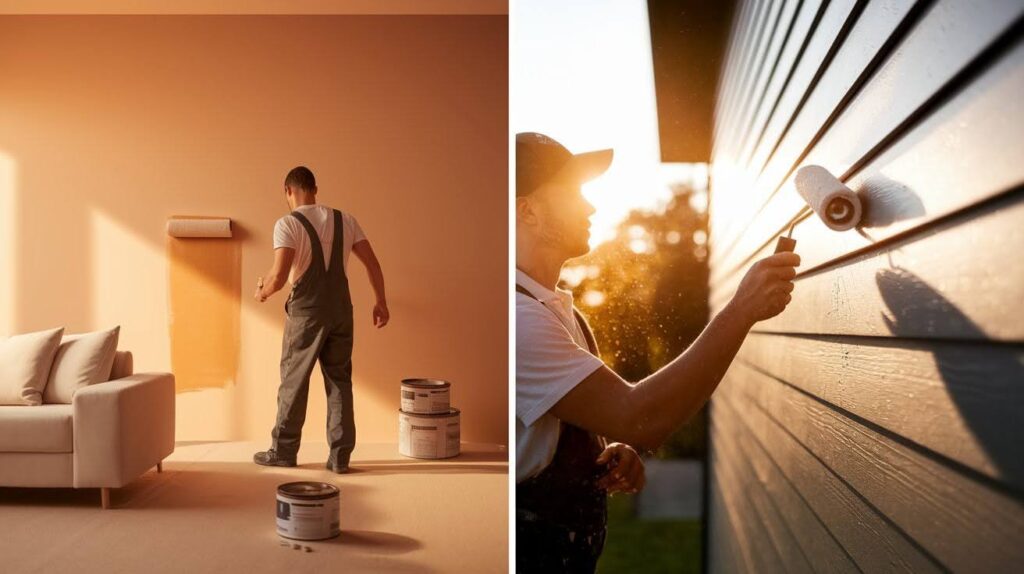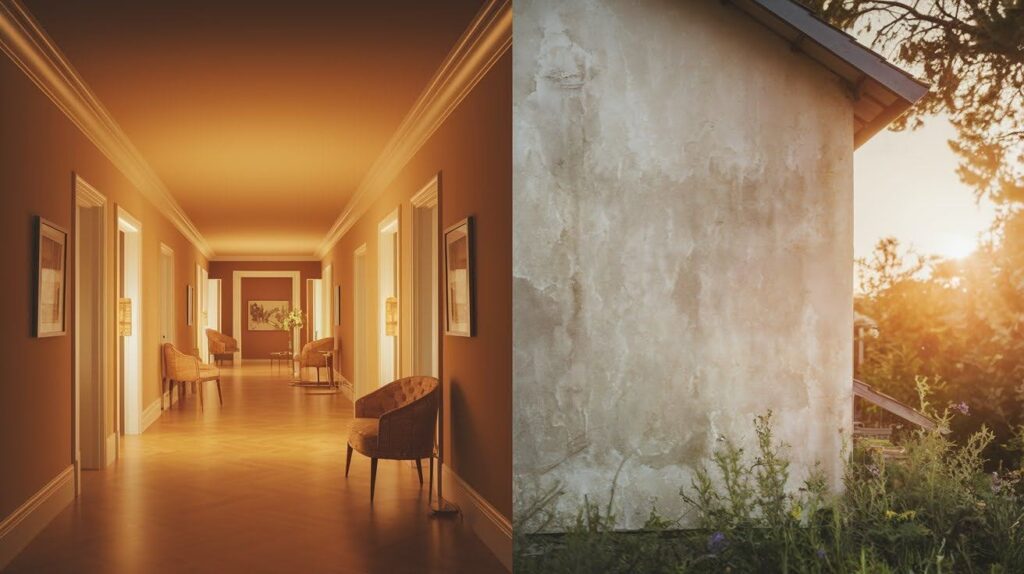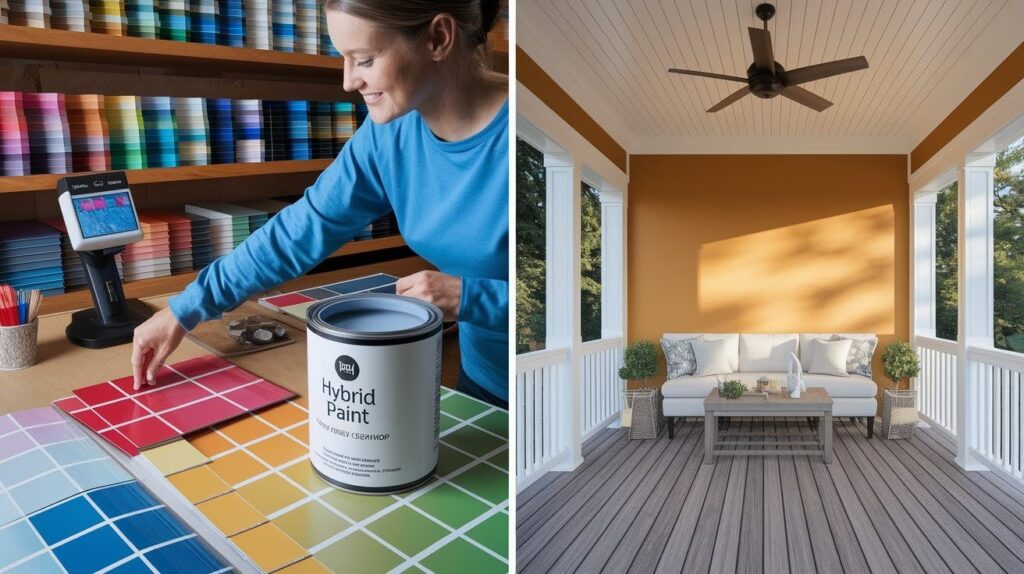In my fifteen years as a painting contractor, I’ve received this question more times than I can count, “Can I just use my leftover interior paint on my deck?” or “I love this indoor color, will it work on my shutters?” I completely understand the appeal.
You’ve got half a gallon of that perfect shade sitting in your garage, and the exterior project you’re planning seems like the ideal opportunity to use it up.
But here’s what I’ve learned from watching countless well-intentioned homeowners make this costly mistake: interior and exterior paints are fundamentally different products designed for very different challenges.
This seemingly simple question has significant implications for your project’s longevity, appearance, and your wallet. Let me share what every homeowner needs to know before making this decision.
Understanding the Basics of Paint

Before we get into the specifics of interior versus exterior use, let me explain the fundamentals that every homeowner should understand. Over the years, I’ve found that clients who grasp these basics make much better paint choices for their projects.
Types of Paint: Water-Based vs. Oil-Based
Water-based paints, also called latex paints, are what most people use today. They clean up easily with soap and water, dry quickly, and have minimal odor.
I recommend them for most interior walls and many exterior surfaces because they’re user-friendly and perform well in typical conditions. However, they can struggle in extreme weather or high-moisture environments.
Oil-based paints create a harder, more durable finish that stands up better to heavy use and harsh conditions. They’re my go-to choice for trim, doors, and surfaces that take a beating. The downside?
They’re messier to work with, take longer to dry, and require mineral spirits for cleanup. They also have stronger fumes that some people find uncomfortable.
Key Components of Paint
Every paint contains four essential components that determine how it performs, and understanding these helps explain why interior paint fails outdoors.
Pigment: provides the color and opacity. High-quality pigments resist fading, while cheaper ones can shift or fade quickly when exposed to sunlight. This is why that beautiful interior blue might turn chalky and dull after one season outside.
Binders: hold everything together and help the paint stick to surfaces. Interior paints use binders optimized for stable indoor conditions, while exterior paints need tougher binders that can handle temperature swings and moisture without cracking or peeling.
Liquids and VOCs: are the carriers that make paint spreadable. Once applied, these evaporate to leave the final paint film. Interior paints focus on low odor and easy application, while exterior paints balance workability with durability.
Additives: make the biggest difference between interior and exterior formulations. Exterior paints include UV blockers to prevent sun damage, mildew inhibitors for moisture protection, and flexibility agents that help the paint expand and contract with temperature changes.
Interior paints typically skip these costly additives since they’re not needed indoors.
Can You Use Interior Paint Outside?
The Short Answer
Technically, yes, but I strongly advise against it. I’ve seen this experiment fail dozens of times. Paint manufacturers create separate formulations because outdoor conditions demand different performance characteristics than stable indoor environments.
What Happens If You Do?
Problems start showing within months. Fading happens first as UV rays break down pigments – I’ve seen deep blues turn gray in one summer. Cracking and peeling follow as interior paint lacks flexibility for temperature changes.
The real issue is shortened lifespan. Quality exterior paint lasts 7-10 years, while interior paint outdoors fails within 1-2 years, requiring expensive repainting and surface preparation.
Interior vs. Exterior Paint: What’s the Difference?

After years of explaining this to clients, I’ve found the easiest way to understand paint differences is to think about what each type needs to survive.
Pigment Durability
Interior paints often use organic pigments that create vibrant, rich colors but break down quickly under sun exposure. Exterior paints rely heavily on inorganic pigments, think titanium dioxide and iron oxides that resist UV damage.
These inorganic options might limit your color choices slightly, but they won’t leave you with faded, chalky walls after one season.
Binder Strength
Interior paint binders focus on resisting scuffs and everyday wear from furniture and foot traffic.
Exterior binders are engineered for a completely different battle, they need to handle moisture penetration, temperature swings, and constant expansion without cracking or developing that chalky residue you see on failed paint jobs.
VOC Levels and Safety
Here’s where things get interesting. Interior paints keep VOCs low because you’re breathing that air daily. Exterior paints actually contain higher VOC levels to boost durability and weather resistance.
This is another reason why using exterior paint indoors isn’t smart-you don’t want those stronger chemicals in your living space.
How to Make It Work: Using Interior Paint Outside

I’ve warned against this throughout the article, but sometimes circumstances force your hand. If you absolutely must use interior paint outdoors, here’s how to maximize your chances of success.
Remember, even with perfect preparation, you’re still working against the paint’s fundamental design limitations.
Proper Surface Preparation is Critical
Clean thoroughly and sand glossy surfaces for better adhesion. Use high-quality exterior primer, it’s absolutely essential. On porous surfaces like wood or masonry, apply two primer coats.
Skipping primer guarantees early failure, and proper prep work is your only defense against premature paint breakdown.
Choosing the Right Type of Interior Paint
Oil-based interior paints perform better outdoors than latex. Choose satin or semi-gloss finishes, avoid flat paint completely as it offers no protection against moisture and wear. Higher-quality interior paints with better binders will last longer than budget options.
Application Best Practices
Paint only in mild, dry weather between 50-80°F. Apply thin, even coats and allow full curing time between applications. Thick coats crack faster, and rushed drying weakens durability. Consider applying an extra coat beyond what you’d normally use indoors for added protection.
Maintenance Tips for Interior Paint Used Outdoors
- Inspect surfaces every few months for cracks, peeling, or fading
- Touch up problems immediately to prevent water damage
- Apply clear protective sealants annually to high-wear areas
- Keep sprinklers away from painted surfaces
- Plan for complete repainting within 2-3 years maximum
Alternatives to Consider

Before you resign yourself to using interior paint outdoors, let me share some better solutions I’ve used with clients who faced the same dilemma.
Color Matching Exterior Paint
Here’s what most homeowners don’t realize: you can get almost any interior color reproduced in an exterior paint formula. I’ve helped countless clients who fell in love with a specific shade from an interior collection get that exact same color in a proper outdoor formulation.
Most paint stores can scan your interior paint sample and mix it using exterior-grade pigments and binders. The color might shift slightly due to different pigment types, but it’s usually close enough that you won’t notice the difference once it’s in your house.
Hybrid Paints
Some manufacturers now offer interior/exterior combination paints that work reasonably well in both environments.
I’ve used these successfully on covered porches, three-season rooms, and other transitional spaces where you need something more durable than interior paint but not full exterior protection.
These hybrid formulations compromise between the two categories, they’re tougher than interior paint but not as weather-resistant as true exterior paint. They work best in protected areas with limited direct weather exposure.
The key is understanding their limitations and using them in appropriate applications rather than expecting them to perform like specialized exterior coatings.
Conclusion
Throughout my career, I’ve watched countless homeowners learn this lesson the hard way: paint formulations exist for good reasons. Interior paint lacks the UV protection, flexibility, and weather resistance needed for outdoor survival.
What seems like a money-saving shortcut inevitably leads to premature failure, fading, and costly do-overs.
The bottom line is simple, use interior paint indoors and exterior paint outdoors. Your surfaces will look better longer, and you’ll avoid the frustration of watching your hard work deteriorate within months.
When you’re facing a complex project or dealing with challenging surfaces, there’s no shame in seeking professional advice. I’ve built my reputation on helping homeowners make smart choices from the start.
Sometimes a quick consultation can save you years of headaches and unexpected expenses down the road.
Frequently Asked Questions
What happens if I accidentally use interior paint on my exterior trim?
The paint will start failing within 6-12 months with fading, cracking, and peeling. You’ll need to scrape it off and repaint with proper exterior paint.
Can I mix interior and exterior paint together to make it work outside?
No, mixing doesn’t combine their protective properties and often creates problems. The mixture still lacks UV protection and weather resistance.
Is there any outdoor surface where interior paint might work temporarily?
Covered porches with minimal sun exposure might last slightly longer. Even then, expect a much shorter lifespan than proper exterior paint.
Why does interior paint cost less than exterior paint?
Interior paint uses cheaper ingredients without UV blockers or weather-resistant additives. Exterior paint costs more for specialized durability ingredients.
Can I use exterior paint indoors instead of interior paint?
Exterior paint has higher VOCs and stronger odors unsuitable for living spaces. Use interior paint designed for indoor air quality.

